Did I get your attention? I’m talking about birdie love, of course, and we got an eyeful on this stop! If you’re a birder, bird watcher/photographer or a nature enthusiast read on, because that’s what this post is all about.
 Our first stop in Texas was at High Island. Ever since our friends Eric and Laurel had blogged about their visit here, it became a must-do for me. Although they advised a visit during peak migration time in April, our own migration called for us to be west of the Mississippi by then to avoid the worst severe spring weather. Fortunately, an excellent show was already unfolding when we arrived!
Our first stop in Texas was at High Island. Ever since our friends Eric and Laurel had blogged about their visit here, it became a must-do for me. Although they advised a visit during peak migration time in April, our own migration called for us to be west of the Mississippi by then to avoid the worst severe spring weather. Fortunately, an excellent show was already unfolding when we arrived!

In addition to the five sanctuaries managed by the Houston Audobon on High Island, we also visited Bolivar Flats Sanctuary east of Galveston and the Anahuac National Wildlife Refuge north of High Island. There’s no such thing as too many bird sanctuaries!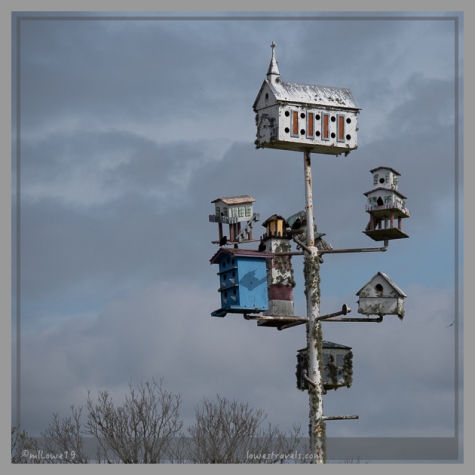
Our first foray led us into Anahuac Wildlife Refuge. Instead of driving the auto drive we walked it, allowing us to burn some calories from our previous cajun country food experience. This is supposedly the only refuge in Texas with alligators, and we saw many young and old ones lurking in the water and hiding along the reeds. But it was the thousands of birds near and far that got my heart pumping!
The hot pink babes were flying over, what a sight!
To see thousands of shorebirds wintering at Bolivar Peninsula, we had to get up early and during low tide at three locations; at Bolivar Flats, at the north jetty and at Rollover Pass. This is when countless birds can be seen feeding on the mud flats. The downside was that many of them were too far away for my camera lens to reach. But we still enjoyed watching them feasting from a distance.

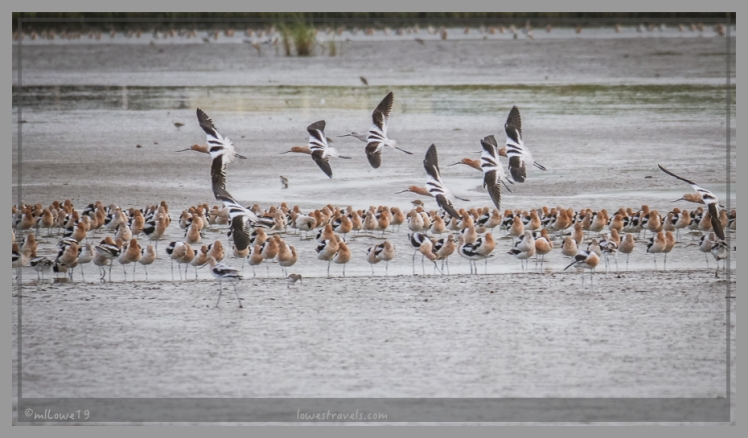
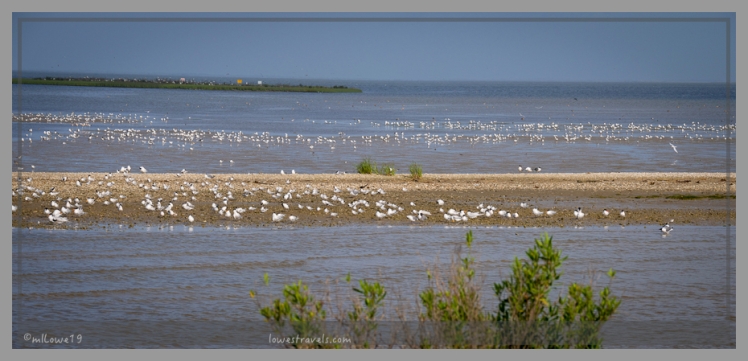

After visiting those outlying sanctuaries we turned our focus to the five bird sanctuaries at High Island. Fortunately, most of them were within walking distance of our campground so I could visit several times during our stay.
High Island is one of the most popular birding destinations in the U.S. during spring. It’s a natural refuge (and layover) for weary migrating birds traveling from the Yucatan Peninsula, across the Gulf of Mexico and up to their northern summer homes here and in Canada. The town is small with a population of only about 500, but that number swells from around April 1st to May 15th when birdwatchers descend. The sanctuary recorded 28,000 visitors in 2018!

The sanctuaries are fee sites, with $8 per person per day giving access to all five of them. But I purchased the $30 patch which gave me unlimited admission during our stay. Having seen how well maintained and managed the sanctuaries are, it was totally worth it. One spot to see migrant birds is Boy Scout Woods, where crowds of serious birders congregate during peak times. Even though spring migration was not yet in full swing, I managed to spot two tiny skittish birds that are difficult to capture:
Our attention was also drawn to Smith Oaks Rookery, a 142-acre sanctuary that provides critical habitat for resident and migratory birds. This was our first up-close visit to a large rookery, and we were blown away! Hundreds of Herons, Egrets, Cormorants and Roseate Spoonbills build their nests and raise their chicks on this predator-free island. There are also some nice hiking paths here that lead around new areas being developed for even more nesting birds.

From a platform, we were voyeurs watching a live love show, a natural performance on an island. There was non-stop comings and goings of birds hunting for sticks to build nests, all the while displaying themselves for courtship. They were extremely active and noisy – there was so much going on that I didn’t know where to focus my camera!

The birds unabashedly displayed their showy breeding plumage, and each one had their own way of conducting the “stick hunt” for nest building.
Neotropic Cormorants
These guys were the noisiest, emitting an “oinking” sound:
Snowy Egret
Also nicknamed “Yellow Slippers” because of their yellow feet, these birds are a common sight around ponds and lakes. I learned that they’re actually a small heron, all white in color except during breeding season when their facial color turns from yellow to red and their legs to an orange-yellow hue:

Great Egrets
The lacy courtship of snowy beaux is fascinating to watch. Males perform most of the displays, involving preening the wings, ducking the head, holding and shaking twigs in the bill, and stretching the neck.
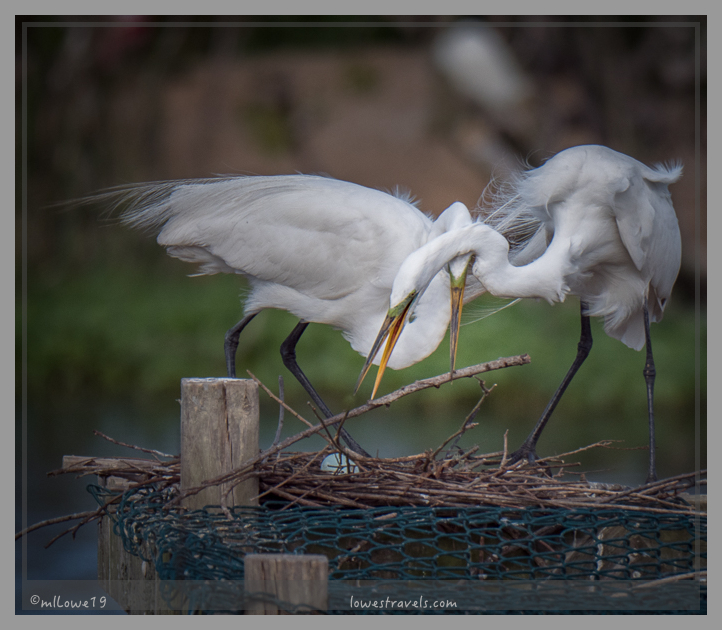
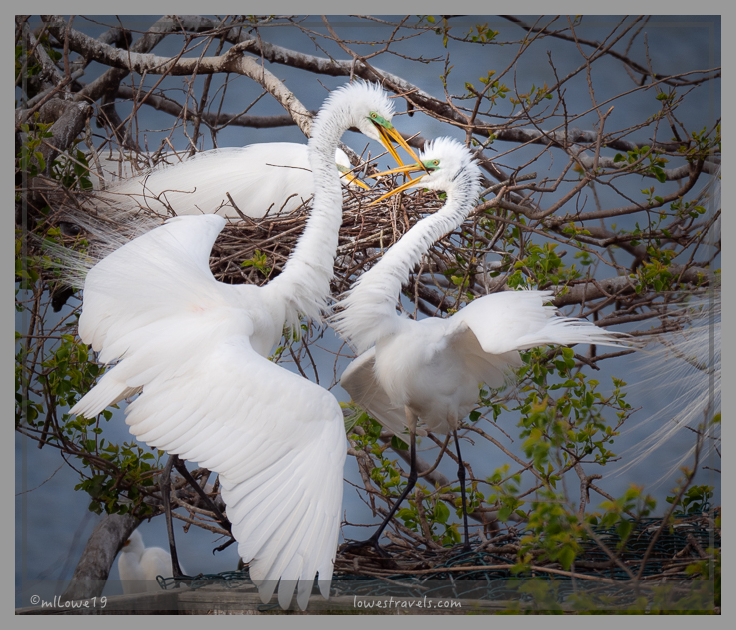
Roseate Spoonbill
This unique and gorgeous species is my favorite big bird, and I was ecstatic to be observing them up close. In their breeding plumage, they have bold scarlet shoulders, a very bright pink-orange tail, an orange ring around the eyes, dark red legs and a white/grey bill. Wow!

During courtship, the pink babes initially interact aggressively. I found them perched together, crossing and clasping their bills. They also participate in stick hunts, presenting gathered sticks to each other.


Crossing and clasping bills, a tender moment during courtship:
The pink pigments in the Roseate Spoonbill’s plumage come from its diet of shrimp, crabs and other crustaceans.

Of all the courtship and mating dances, my favorite was that of the Great Egret. It was like watching a ballet, slow and majestically choreographed. It was wonderful to witness these magnificent and beautiful creatures in their natural breeding environment.












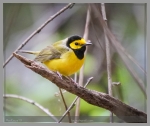












Love indeed … I’m loving all these photos. What a birders paradise. You captured some stunning images!
Thanks, Ingrid, if you were there, your camera will be hard pressed to which pair to focus on.
Be sure and give me a heads up when you’ll be in Wickenburg.
No video of the Great White Egret courtship dance???!!! You have me begging for more!
Terri, I wished I had, especially the stick presentation and the Egrets courtship dance! I was just too excited to think about a video!
I love the pattern on the flying Avocet’s backs. I’ve not seen them in flight before.
The bird’s breeding plumage is so beautiful nature has a plan!
Everyone thinks the Roseate Spoonbills are the most beautiful but, if they weren’t such a spectacular color would people still think they are so pretty?
Good point Sue, so I converted the Spoonbill’s photo to black and white and the bird looks so different. It will still be pretty and I’m sure prettier than the Woodstork 🙂
Fantastic! We’ve walked under the small cormorant/blue heron rookery at Willow Lake in Prescott and were amazed at the jungle sounds we heard. I can’t even imagine what a large rookery must have been like! Beautiful photos!
How exciting to see these beautiful birds during mating season! Your photos are amazing. Asks for sharing.
I meant thanks for sharing.
A rookery during breeding season is the place to get amazed!
You took so many fantastic photos but my absolute favorite is the first one of the great egret. That is just stunning! The roseate spoonbills are especially beautiful too, and it’s interesting to see their different colors during breeding season – they’re always pretty, but seeing them all dressed up and ready to hit the clubs in search of love on a Saturday night? Awesome! 😃
I like your analogy, they were not only dressed up for a Saturday night, they were also ready for a roll in the day 🙂
You got some super shots there at High Island, it’s one of our favorite rookeries.!
Thank you!
What a paradise for you!! In my youth, we would rent beach “cabins”, like those you picutured, on Bolivar Peninsula. Great memories from that time.
You bet, you know me and the birds 🙂 Those are cabins on stilts! I imagine it would be a daily work out just to go up and down those stairs.
Beautiful photos! The plumage and behavior of waterfowl and shorebirds is incredible. The Great Egrets shots are probably my favorite.
Steve who says he is just my driver when we go to bird places, was blown away. It was an amazing experience watching nature do their thing.
I’m so glad you made it to High Island! Your photos are absolutely spectacular. You did such a fantastic job of capturing the beauty of the birds in their fancy breeding plumage as well as their elaborate courtship displays and rituals.
Our visit there a couple of years ago is still one of the highlights of our birding adventures, and looking at your photos and reading your post makes us want to return. 🙂
Oh thank you so much for sharing your own experience, we would have not known about this great rookery. Even Steve who is not a birder was blown away with all the actions and the pretty birds!
You were certainly in your glory with so many wonderful birds. Your photos are spectacular but the Roseate Spoonbill photos are my favorite. You captured their brilliant pink perfectly.
I was definitely in bird heaven! and finally learned about their breeding plumage and mating behavior.
The Egret plumage photo is amazing. Thanks for sharing about such a wonderful location and the fun times you had. Continue to look forward to your posts. We love the Roseate Spoonbills too.
They were amazing and they were all so magnificently dressed to impress.
Your excitement over and photos of the spectacular birds makes me want to be a birder, too. I don’t know if I’ll ever get to see half of the feathered beauties you’ve seen, but that makes me appreciate your sharing all the more special. Really, really nice photos, wonderfully captured!
Appreciating and photographing birds just grew on me, and it all began when I joined a bird walk at Patagonia AZ. Although I try not to hang out with real birders because they are so intense!
Wonderful pictures of beautiful creatures. Thanks for writing a little bit about each. I especially liked the story about the stick collection and presentation.
I would call it a slow dance with a stick, that put me in a trance. And all pairs were doing the stick hunt, it was a busy noisy colony!
SImply magnificent. I loved watching the egrets at Chicoteague during mating season … those lacy plumes are so beautiful.
They really are and their courtship is so elaborate!
Beautiful images of the egrets! So amazing!
Thank you, the Great Egrets are more beautiful when they are in their breeding plumage.
Wow! Fabulous bird pictures. We’ll have to try and visit there sometime.
Oh yes, the rookery is a photographers dream. IF you go visit the area be there between April-May for the breeding season or migration.